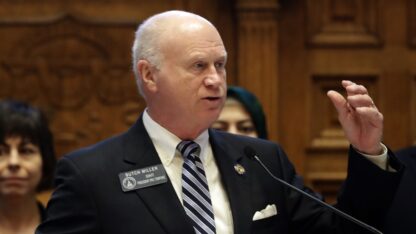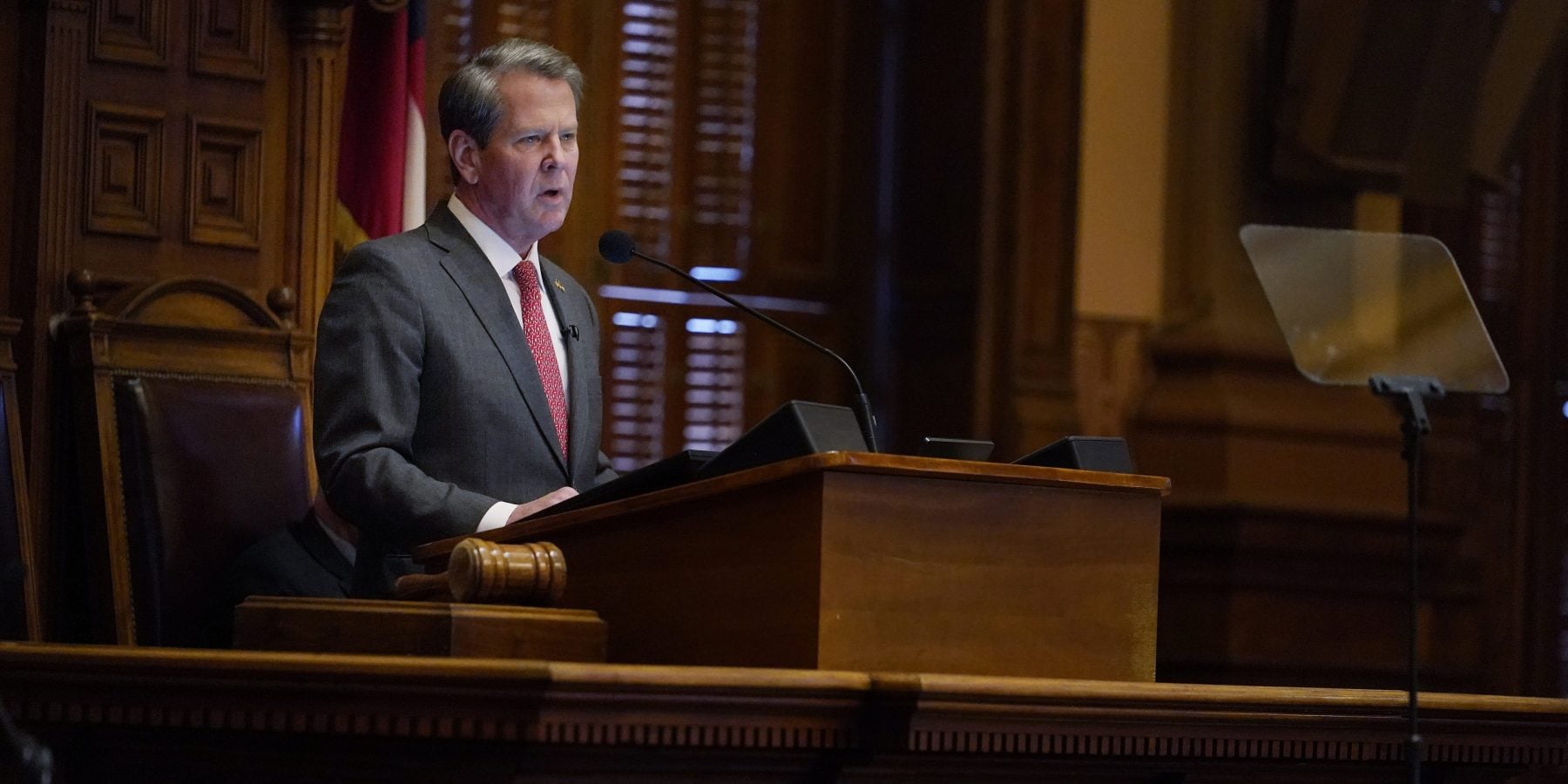Georgia Purged About 107,000 People From Voter Rolls: Report
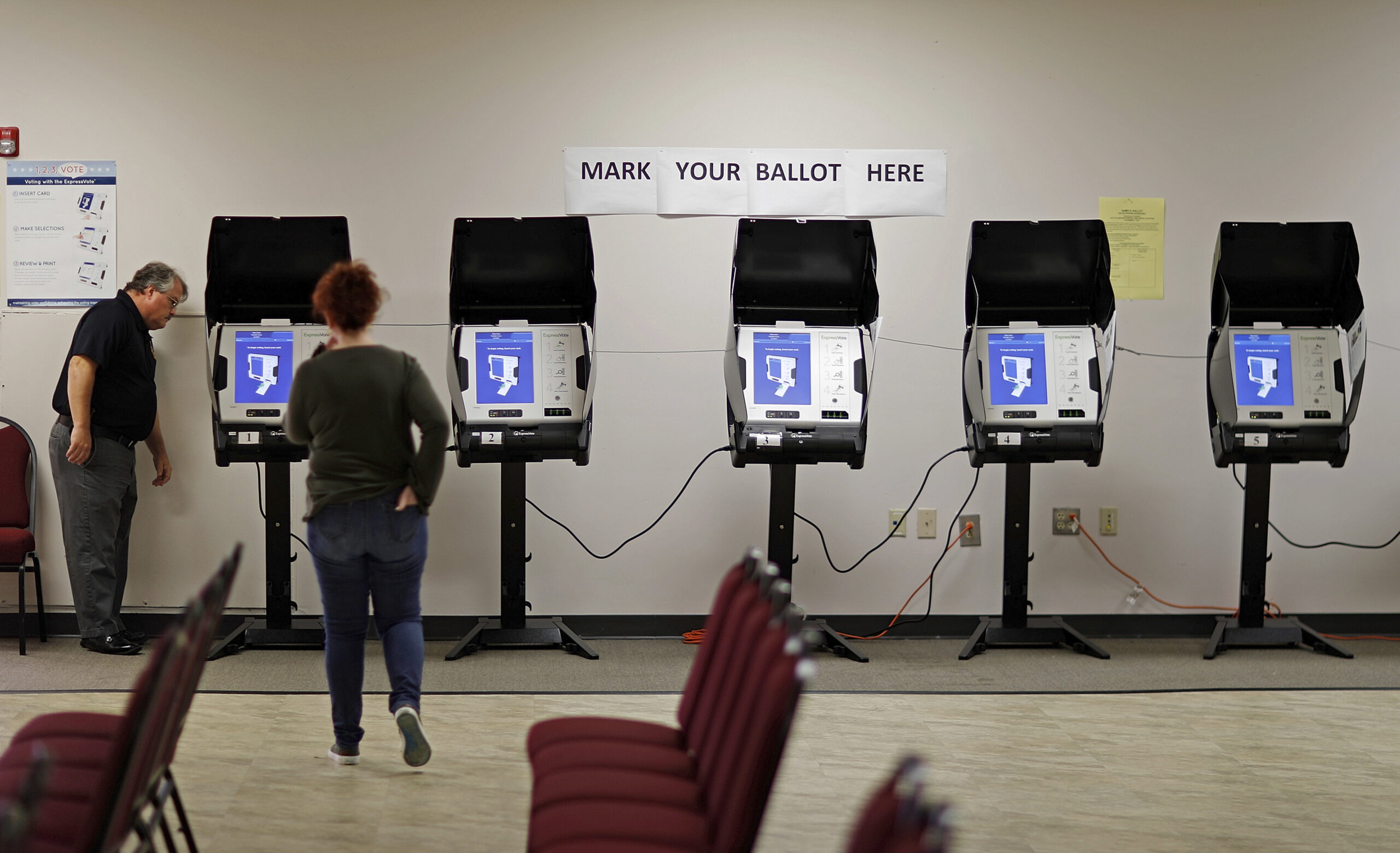
For an estimated 107,000 people, their removal from the voter rolls was triggered because they had decided not to vote in prior elections, according to an APM Reports analysis.
David Goldman / Associated Press
Georgia purged an estimated 107,000 people largely for not voting, an APM Reports investigation shows A handful of states, most of them led by Republicans, are increasingly using someone’s decision not to vote as the trigger for removing them from the rolls. No state has been more aggressive with this approach than Georgia, where Brian Kemp, the secretary of state, oversaw the purging of a growing number of voters ahead of his own run for governor, according to an APM Reports investigation. Voting rights advocates call it a new form of voter suppression, and they fear it will soon spread to other states.
This story was reported in collaboration with WABE in Atlanta, KCUR in Kansas City and Reveal from the Center for Investigative Reporting.
Even by Georgia standards, the voter purge of late July 2017 was remarkable. In a single day, more than half a million people — 8 percent of Georgia’s registered voters — were cut from the voter rolls. Republican Secretary of State Brian Kemp, an avid supporter of President Donald Trump who has described himself as a “politically incorrect conservative,” oversaw the removals eight months after he’d declared himself a candidate for governor.
The purge was noteworthy for another reason: For an estimated 107,000 of those people, their removal from the voter rolls was triggered not because they moved or died or went to prison, but rather because they had decided not to vote in prior elections, according to an APM Reports analysis. Many of those previously registered voters may not even realize they’ve been dropped from the rolls. If they show up at the polls on Nov. 6 to vote in the heated Georgia governor’s race, they won’t be allowed to cast a ballot.
Kemp’s opponent, Democrat Stacey Abrams, is vying to become the first African-American woman in U.S. history to serve as a governor. The state has undergone a dramatic influx of African Americans and Latinos whose votes could challenge Republican dominance, and her campaign is trying to turn out people of color, who are more likely to be infrequent voters. If the race is close, the July 2017 purge could affect the outcome.
The APM Reports analysis is the first estimate of the so-called “use it or lose it” policy’s possible impact in Georgia. While 107,000 people may seem like a small number in a state with a population of 10.4 million, elections have been decided by far smaller margins. For instance, the 2016 presidential election was decided in favor of Donald Trump by a total of 77,744 votes in Wisconsin, Michigan and Pennsylvania.
Using someone’s decision not to vote as the trigger to remove that person from the rolls is a highly controversial — yet legal — tactic that voting rights advocates say is a potential tool for voter suppression. And its use is on the rise.
APM Reports found that at least nine states — most of them with Republican leadership, including the key battlegrounds of Georgia and Ohio — have purged an estimated hundreds of thousands of people from the rolls for infrequent voting since the 2014 general election. States with these policies are removing voters at some of the highest rates in the nation, no matter the reason.
Voter purges are not necessarily controversial or unusual. Hundreds of thousands of Americans who have moved, died, or gone to prison get kicked off voter lists across the country every year. In fact, federal law requires states to cull people from rolls who are no longer eligible to vote. But in the states that employ “use it or lose it” policies, U.S. citizens in good standing who haven’t moved, committed a crime or otherwise jeopardized their right to vote, can trigger the removal process because they didn’t show up at the polls.
Election officials say that they’re trying to keep voter registration lists accurate and prevent voter fraud. They consider it safe to assume that people who don’t vote in multiple elections, or return confirmation notices, have moved.
“We’re following the process,” Kemp said in a recent interview with public radio station WABE in Atlanta, arguing his office had not only complied with state and federal law but was registering more voters than ever. “I’m very proud of my record on making sure we have secure, accessible and fair elections.”
But voting rights advocates fear that “use it or lose it” purges could be used as a voter suppression tactic — along with voter ID requirements, gerrymandering, polling place changes or closures, and registration obstacles — that often help conservative candidates, because infrequent voters tend to be younger, poorer and people of color who are more likely to favor Democrats. For instance, the APM Reports investigation found that such purges in Ohio disproportionately affected urban, Democratic-leaning counties.
Advocates predict that more states could soon adopt similar policies following a controversial 5-4 decision by the U.S. Supreme Court in June that “use it or lose it” policies don’t violate federal law.
Justin Levitt, a former Justice Department lawyer in the Obama administration turned professor at Loyola Law School in Los Angeles, said a problem with the policy is that infrequent voting doesn’t necessarily prove that a person isn’t eligible. “So, I sat out a couple elections. I didn’t respond to a postcard and sat out a couple of elections,” he said. “It doesn’t say I’ve moved. It doesn’t say I’ve died. It doesn’t say in any way that I’ve given up my right.”
A state with a troubled past
One of the first people to wonder about the recent impact of “use it or lose it” policies in Georgia was an Atlanta-based attorney named Emmet Bondurant. It was 2012, and he was reading an article in the Atlanta Journal Constitution about a decline in the state’s voter registration. How, he wondered, could a state growing as fast as Georgia have shrinking rolls?
“We haven’t had a black plague. We haven’t had more than the usual number of people convicted of crimes. We haven’t had a major recession like the Dust Bowl that drove the Okies to California,” Bondurant said on a recent afternoon from the corner office of his corporate law firm, which, on a clear day, offers a view of the distant Appalachian Mountains. “The population in the state has increased and grown above the national average,” he recalled thinking. “And yet the number of registered voters [was] going down.”
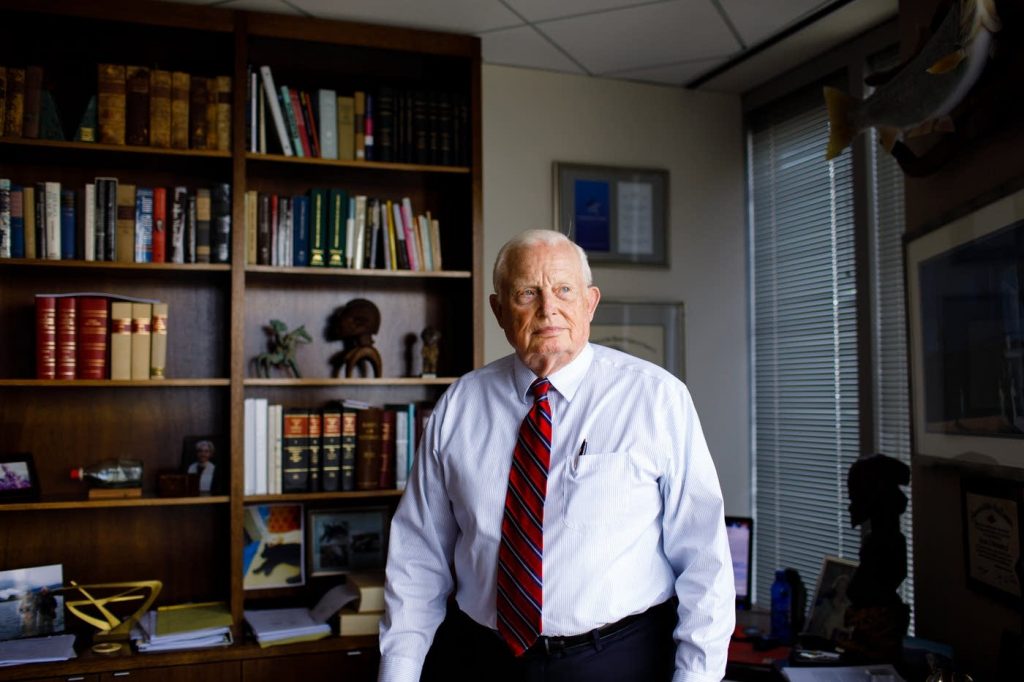
Bondurant, 81, is a successful corporate attorney and somewhat of a voting rights legend in Georgia. He got his first big break in 1963 when, at 26, he argued and won a case before the Supreme Court that challenged the undue political influence of sparsely populated, rural areas at the expense of larger more urban ones. It was a significant victory for African-American voting rights in the state; by granting rural areas more influence, the state had prolonged white control. The next year, he was part of a legal team that scored another victory in the high court over similar voter suppression in Georgia. The cases were part of a string of victories for voting rights advocates, culminating in passage of the Voting Rights Act in 1965 that outlawed barriers to voting implemented by the Jim Crow South, including literacy tests in Georgia. Bondurant has continued to do pro-bono voting and other civil-rights cases in the six decades since.
As Bondurant saw the voter rolls shrinking, it dawned on him that the “use it or lose it” policy could be depressing registration numbers. And he wanted to do something about it.
Georgia adopted the “use it or lose it” law in the early 1990s — under Democratic leadership — following the adoption of the National Voter Registration Act (NVRA), which was passed in the first year of the Clinton administration to boost voter registration and participation. It’s often called the “Motor Voter” law because, among many other provisions, it allowed states to register people at the department of motor vehicles. The NVRA also laid out a process for states to ensure that voter lists are accurate by purging voters who’d moved, died or gone to prison.
At the time, the Justice Department initially objected to Georgia’s “use it or lose it” law. In 1994, Deval Patrick, then-assistant attorney general of the Justice Department’s civil rights section who would later be elected governor of Massachusetts as a Democrat, warned Georgia officials in a letter that the new law was “directly contrary to the language and purpose of the NVRA, and is likely to have a disproportionate adverse effect on minority voters in the state.”
Georgia’s “use it or lose it” law remained in place. In years to come, a growing number of Georgians would find themselves purged from the voter rolls because of it. This rise in purges had alarmed Bondurant, and the increase had coincided with the tenure of Georgia’s new secretary of state — Brian Kemp.
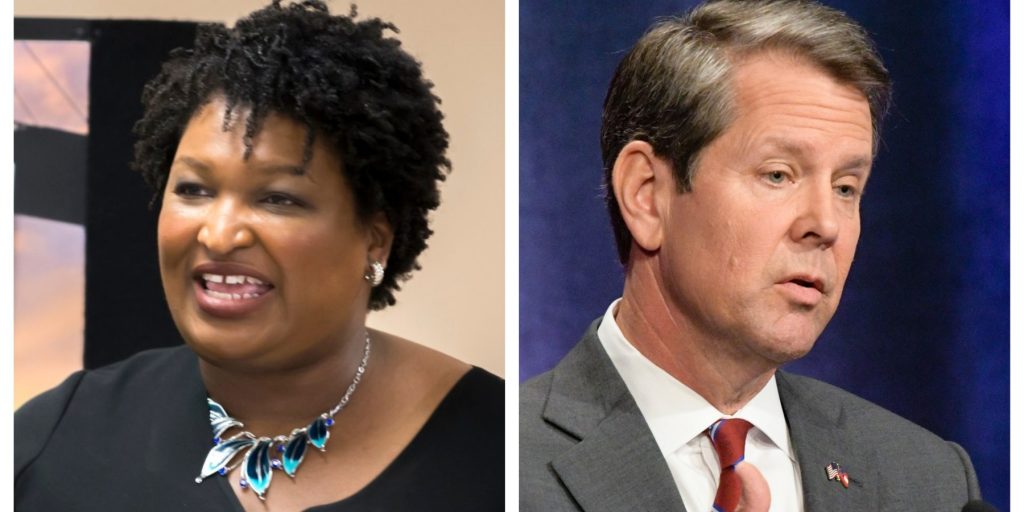
Kemp’s purges
Kemp, a former state senator, took over as Georgia’s top election official in January 2010 when then-Gov. Sonny Perdue appointed him to an unexpired term. He’s since won reelection twice. Kemp took office at a time when voter purges across the country began to grow. An APM Reports analysis of federal data shows that voter removals nationwide increased 11 percent between 2010 and 2016, by more than 1.6 million.
The 2008 election marked a turning point not just because Americans elected the first-ever African-American president, but also because Barack Obama performed exceptionally well in states that Republicans had dominated for at least the previous decade.
Thanks in part to a huge turnout by African-Americans, Obama won Virginia, North Carolina, Indiana and got within 5 percentage points in Georgia (George W. Bush had won the state by 17 points in 2004).
In Georgia, active voter registration grew by 18 percent in 2008 compared with 2006. An additional 362,000 African Americans were added to the voter rolls that cycle, a 30 percent increase. There was also a 69 percent surge in Latino registrations and a 44 percent increase in the number of Asians added to the voter rolls between 2006 and 2008. But after Obama was elected, participation lagged, and not just in Georgia. More than 100 million Americans of voting age didn’t cast ballots in 2016.
At the same time, voter list removals across the country began to rise, especially in some battleground states where Obama had performed well in 2008, according to an APM Reports analysis.
But few states have increased voter purges more than Georgia. In the 2010 election cycle, when Kemp first took office, nearly 379,000 people were removed in counties across the state, according to data the state reported to the U.S. Election Assistance Commission. By 2014, the number of voters canceled increased by more than 35 percent, to 517,000, according to state data. In all, counties across Georgia reported removing more than 1.6 million from the rolls in the past decade. Some of these registrations (11 percent in 2017) were canceled because the voter died or was convicted of a felony.
In Georgia, a registered voter can be flagged for a purge if he or she doesn’t vote or make contact with election officials for three years. Election officials then send a notice in the mail to inform the person that he or she may be purged. If the person doesn’t respond, contact election officials or vote in two subsequent elections, then he or she will be removed. It’s a seven-year process. So people who voted in the high-turnout 2008 election but skipped 2010 through 2016 were dumped in 2017.
That may explain why the July 2017 purge was the biggest one yet under Kemp. More than 591,000 Georgians had their voter registrations canceled that year, according to the secretary of state’s office. State records show that 560,000 voter registrations were canceled for inactivity.
Not all were removed for not voting, however. The APM Reports investigation found that the state is broadly applying the term inactivity to remove voters. It includes people who have moved and who even voting rights advocates would agree should be purged from the lists. Georgia maintains no clear data on how many people have been purged under “use it or lose it.”
So APM Reports analyzed state voter records to determine roughly how many people were purged because they moved and how many were purged because they hadn’t voted. By using estimates from the U.S. Census Bureau’s American Community Survey of how many Georgians moved, APM Reports calculated that about 107,000 people — or about 18 percent of all voters removed — were purged in 2017 for reasons that the data suggested couldn’t be attributed to moving.
The finding is the first public estimate of how many people in Georgia — which, along with Ohio, is one of the most prolific “use it or lose it” states — were purged for failure to vote and respond to a notice.
“A lot of our race is basically wondering is it really worth it.”Pastor Cornelius Ponder III
Kemp, who, like many conservatives, prefers to call the process “voter list maintenance,” defended his office’s use of “use it or lose it” as an effective way of protecting elections from voter fraud. “So you think we should just leave people alone in perpetuity? I mean, what happens if they move to another state? People all the time move to another state, and they don’t tell us and end up getting on the voter rolls in two different states. We’ve had the same person voting twice in two different states in presidential elections. So there’s a reason you keep the voter rolls current and up to date,” Kemp said. “We don’t have near the problems other states have with with voter fraud, I believe, but we do have it.”
Georgia officials have pursued 19 election fraud cases in the past two decades; seven of those cases resulted in a criminal conviction, according to the Heritage Foundation, a conservative think tank. Kemp’s critics argue that there’s little evidence that voter fraud is a serious threat to elections and that the true aim is to make it more difficult for minority voters to cast a ballot.
There’s indication that purges have disproportionately affected minority voters in some places. Analyzing all the Georgians purged in 2017, APM Reports found that in six of every 10 counties across Georgia, black voters were canceled at a higher rate than their white peers for inactivity. And in more than a quarter of those counties black voter were removed at a rate 1.25 times their white peers.
Purges are just one area in which critics allege that Kemp has tried to suppress the vote, and they’ve repeatedly sued his office for a range of infractions. The latest lawsuit was filed just last week by the Lawyers’ Committee for Civil Rights Under Law, the state chapter of the NAACP and other civic groups alleging that Kemp’s office has slow-walked 53,000 new voter registration applications, a majority submitted by people of color, because of an exact-match policy that was struck down by the courts only to be reinstated by state lawmakers. People on the list can still vote if they show up at a polling place with their photo ID, but the civil rights groups worry they’ll be confused and discouraged.
In fact, more federal voting rights lawsuits have been filed against officials in Georgia than any other state except Texas since 2011, an APM review of court records found. Multiple suits have accused Kemp of wrongly purging voters and creating obstacles to registration efforts.
Of the most common voter suppression tactics studied this year by the U.S. Commission on Civil Rights, a federal agency — voter ID laws, proof of citizenship requirements, purges, cuts in early voting, and polling places closures — Georgia is the only state once under federal oversight to have adopted all five.
“Racial discrimination in voting has been a particularly pernicious and enduring American problem,” the commission wrote in its recently released report. The commission concluded that voter purges, combined with other policies, present ongoing barriers to equal access for voters and “have a disparate impact on voters of color and poor citizens.”
By 2016, Bondurant had had enough and decided to file a lawsuit with Common Cause Georgia, a nonprofit watchdog group, and the state chapter of the NAACP, challenging the legality of “use it or lose it.”
In the lawsuit in federal court, he argued that using failure to vote as the trigger for purging people from the rolls violated federal law. Meanwhile Kemp’s office counters that people have been notified and would remain active if they would take the time to respond to the notice sent out by election officials. Bondurant suspects that most people treat the pre-purge notices as “junk mail” and throw them away.
“It’s a first Amendment issue,” Bondurant said. “You have a right to speak out on something, but you also have a right not to speak out on something. And voting can be thought of in the same way.”
Is it legal?
Around the same time that Bondurant filed his suit, voting right advocates in Ohio were engaged in a similar fight.
In 2016, Larry Harmon, a 59-year-old U.S. Navy veteran, joined a lawsuit against Ohio Secretary of State Jon Husted after being purged for infrequent voting. “You know, I pay my taxes every year, and I pay my property taxes, and I register my car. So the state had to know I’m still a voter,” Harmon told PBS’s “NewsHour.” “I’m a veteran, my father’s a veteran, my grandfather’s a veteran. Now they aren’t giving me my right to vote, the most fundamental right I have? I just can’t believe it.”
Harmon was born and raised in Ohio and had lived at the same address for approximately 15 years. When he tried to vote in the November 2015 general election, he was told that his name did not appear in the poll book. Harmon hadn’t voted in either 2009 or 2010 and was “disillusioned with the presidential candidates” in 2012 so he sat that one out too.
Under Ohio’s version of “use it or lose it” a registered voter can be removed after six years of inactivity, and in 2015, Harmon was removed from the Portage County voter registration rolls because he had not voted since 2008, court records show.
Husted, who is also running for lieutenant governor this year, defended the practice, arguing that his office was simply following the law and maintaining accurate voter rolls.
At issue in the court battle was the interpretation of the NVRA, which has been politically contentious since its inception. The initial bill, which set out to make voter registration more accessible through state offices and public outreach efforts, was blocked in the Senate by Republicans who feared expanding registration would lead to voter fraud. Among the vocal opponents was now-Senate Majority Leader Mitch McConnell, who scoffed at helping “political couch potatoes.”
The bill was reintroduced in 1993 and signed into law by newly elected President Bill Clinton. While the law requires states to keep their voter lists up-to-date, it explicitly outlaws purging people for not voting.
But lawyers for Husted and Ohio officials contended that their “use it or lose it” approach is legal because it doesn’t purge people solelyfor not voting. Registered voters must skip elections and fail to respond to a notice and not make contact with elections officials in any other way.
The Sixth Circuit U.S. Court of Appeals rejected that argument and struck down the Ohio “use it or lose it” policy in September 2016. In their ruling, the Sixth Circuit judges, which included one appointed by George W. Bush, wrote that even though not voting was just one part of the purge process, under Ohio’s “use it or lose it” approach, it was the key factor.
Ohio officials appealed to the Supreme Court. The case became the latest flash point in the ongoing partisan fight over voter suppression and voter fraud. Georgia and 16 other states — all of them controlled by Republicans or with Republican attorneys general — filed briefs supporting the Ohio policy, as did conservative legal groups such as Judicial Watch and the American Civil Rights Union.
On the other side, 12 states and the District of Columbia — all Democratically controlled or with Democratic attorneys general — along with left-leaning groups such as Common Cause and the ACLU filed briefs opposing Ohio’s “use it or lose it” policy.
Bondurant, the Atlanta lawyer, was watching the Husted case closely. The lawsuit he’d filed in Georgia was on hold pending a decision by the high court. The partisan divide in the Ohio case, he said, only confirmed what he’d suspected all along. “Everybody on both sides of the political aisle sees that this benefits Republican voters.”
In their amicus brief to the Supreme Court, the dozen Democratic states argued that using failure to vote as a trigger for purges was a terribly inaccurate way to maintain the rolls because it doesn’t offer any evidence that people have actually moved. Only about 12 percent of Americans relocate in any given year, the Democratic AGs wrote in their brief, but the percentage of Americans who don’t vote has run as high as 60 percent in recent years. But the Supreme Court ultimately ruled that Ohio’s approach comported with federal law. Writing for the majority, Justice Samuel Alito wrote that “use it or lose it” may or may not be good policy but it didn’t violate federal law.
The ruling scuttled Bondurant’s case as well and ensured that “use it or lose it” would be in place in Georgia for the foreseeable future. Bondurant thinks that the case could get new life if there’s evidence that people of color are disproportionately affected by the purges in violation of the Voting Rights Act. “But until that research is done,” he said, “we’re stuck with secretaries of state like Kemp who, with great enthusiasm and vengeance, want to purge as many people as possible.”
The exact number of people removed under Ohio’s “use it or lose it” law was never revealed through the lawsuit. In a dissenting opinion, Justice Stephen Breyer took a stab at the math and raised questions about why Ohio’s removal rates were so high when people didn’t seem to be leaving the state in droves. “[T]he streets of Ohio’s cities are not filled with moving vans; nor has Cleveland become the Nation’s residential moving companies’ headquarters,” he wrote.
By comparing Ohio purge data with U.S. Census data, as we did with Georgia, APM Reports calculated an estimate of people whose removal was triggered by not voting. According to this analysis, 50,610 registered voters in Ohio could have been removed by the end of the 2016 general election under the “use it or lose it” policy.
In Ohio, voters were purged most in Democratic-leaning counties, which are larger and more urban. Of the five counties with the highest overall removal rates, four went for Hillary Clinton in the 2016 presidential election, an APM Reports analysis of data provided by the Ohio secretary of state’s office shows.
Clinton won just eight of the state’s 88 counties. In four of them — Cuyahoga, Athens, Franklin and Hamilton — more than a million people were removed overall from the voter list between November 2014 and February of 2018, state records show. Voters in those four counties accounted for 43 percent of all removals statewide despite making up just 30 percent of the state’s registered voters in 2016. Trump won the state by nearly 447,000 votes.
After the high court’s ruling, Husted told reporters that he hopes Ohio will “serve as a model for other states to use.” And voting rights advocates fear that more red states will heed his advice.
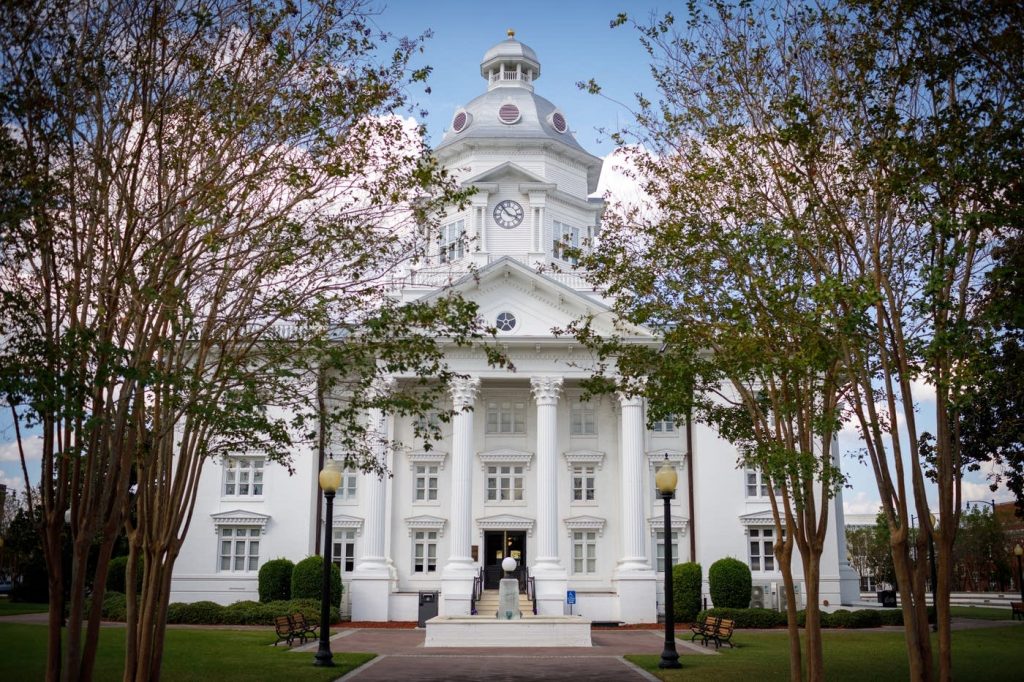
In a small Georgia town, apathy and disillusionment
For the moment, the biggest impact from “use it or lose it” policies may be seen in Georgia, where the Kemp-Abrams race has drawn national media attention.
With Kemp and Abrams neck-and-neck in polls, the election will likely be decided by who turns out to vote. While Kemp has a record of shedding voters, Abrams is open about her strategy: register as many people of color as possible, and inspire them to turn out in unprecedented numbers. The two have clashed repeatedly over those registration efforts. The nonprofit New Georgia Project, launched by Abrams to get more voters involved, became the subject of one of the voter fraud investigations that Kemp’s office has launched in recent years. No evidence of election fraud has been substantiated to date.
In short, Abrams is trying to replicate what happened around the country in 2008 when Obama was running for president. “There’s a pathway for Stacey Abrams to win,” said Republican strategist Brian Robinson who’s done work for congressmen in Georgia, the state’s current governor, and advised one of Kemp’s primary opponents. “Republicans who think that there is not are delusional and they are a danger because it will lead to complacency.”
Democrats are fighting complacency too, especially in the more remote corners of the state. In rural Colquitt County, people like Isabella Brooks, the president of the Colquitt chapter of the NAACP, is trying to motivate voters to turn out for Abrams. It’s hasn’t been easy.
Colquitt is a rural area in southwest Georgia, about 45 minutes from the Florida state line, where most people live clustered in a handful of towns divided by large swaths of cotton fields and livestock farms that have supported the local economy for more than two centuries. It has low voter turnout, especially among African-Americans, and perhaps relatedly, one of the highest purge rates in the state.
On a recent evening as dusk set in, Brooks, her sister and some friends packed into her Ford Fusion to do voter outreach in Moultrie, the county seat. They drove along potholed streets, past ramshackle homes on the black side of town before crossing into the whiter area where the homes are freshly painted and the lawns are lush and wide.
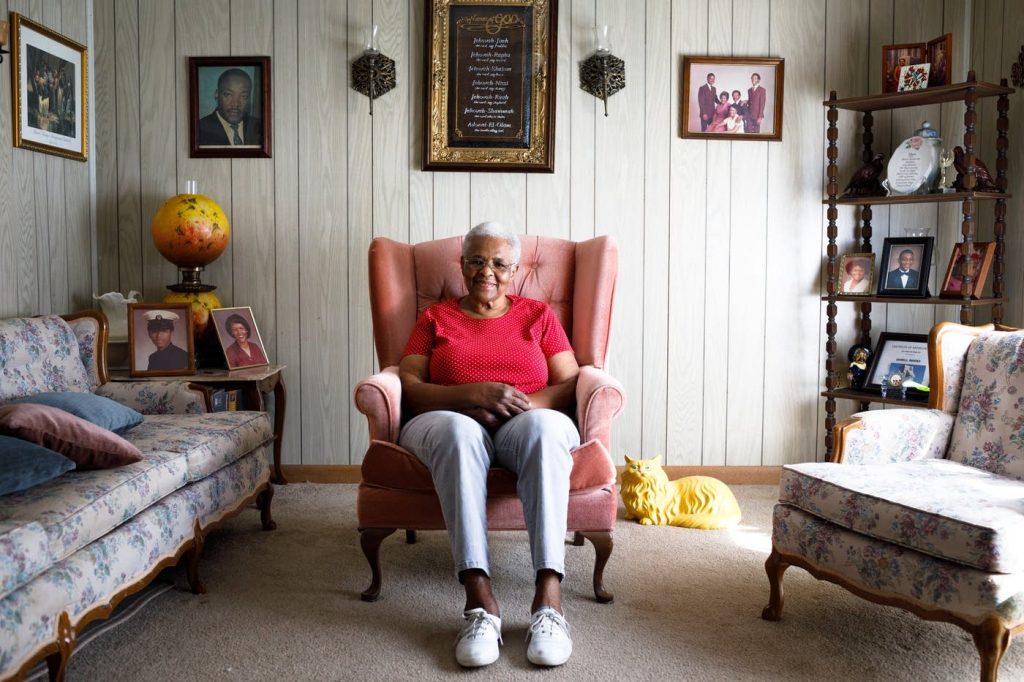
As a child, Brooks recalled, her mother was subjected to a literacy test at a local polling place. “She had to read a long passage,” she said stretching her hands inches apart. “Then she could vote.” It’s a reminder of how voting shouldn’t be taken for granted.
In the white part of town, the Kemp yard signs outnumber the ones for Abrams. But there are a few Democrats to be found. The canvassers, all elderly black women, knocked on doors of registered voters provided by the Democratic Party. They crunched through fallen leaves, leaving fliers on doorsteps. Around 8 p.m., with the sun setting, they tried one last house, where they could see someone inside watching “Jeopardy!” Nobody came to the door, and a canvasser turned around and walked back toward the road, frustrated. It’s a running joke here that most of the local white Democrats are in the closet these days, particularly after Obama was elected.
Levitt, the former Justice Department attorney, says that low voter turnout isn’t good for either party — or the country. And having motivated voters turned away at the polls could only dampen enthusiasm, activists fear. A low turnout could also trigger hundreds of new purges in Colquitt alone next year; about a third of inactive voters in the county are queued up for cancellation before the next presidential election because they haven’t voted in years, according to state data.
If “use it or lose it” states like Georgia adopted same-day registration, experts say, motivated, eligible voters who were purged would have a protection built in so they could still cast ballots. Only one of the nine “use it or lose it” states currently has same-day registration. Bills to add it in Georgia have been introduced a dozen times since 2011, but they all failed to pass the Republican-controlled state House. The uncertainty of Election Day registration — and the possibility of a wave turnout — makes some Republican lawmakers uneasy, because, as Robinson put it: “Weird things happen where states elect some oddball. It leads to irrational voting.”
But same-day registration would help people like Kathlean Ponder, a 66-year-old African-American resident of Colquitt County who was removed from the rolls in the 2017 purge. In 2008, she registered as part of the Obama wave. “I was feeling good about it,” she said. “I had in my mind to vote for him, and that’s what I did.”
She hasn’t cast a ballot or connected with election officials since. She doesn’t recall ever getting a notice that her registration was being canceled. She isn’t a regular voter, but she’s thinking about turning out in November to support Abrams.
Her nephew is Cornelius Ponder III, a pastor and Moultrie city councilman. He said that too many people in his now majority African American hometown have grown so disillusioned with government that they’ve given up on voting, people like his aunt. He fears that any additional obstacles will only reinforce that the system is designed to discourage their vote. “A lot of our race is basically wondering is it really worth it,” he said. “I don’t believe that this generation believes that their votes really matter.”
Ponder has been sharing his congregation’s community center with Brooks and the other canvassers trying to engage with voters, but people like his own aunt have been overlooked by canvassers because they are no longer on the list of active voters. Even Ponder didn’t know that his own aunt had been purged from the voter rolls.
“I think we need to get down to the bottom of it,” Ponder said of his aunt’s purge, “because if it happened to her, I promise you, she’s not the only one.”
Peggy Lowe with KCUR and Johnny Kauffman with WABE contributed reporting to this story. Support for this project was provided by the Corporation for Public Broadcasting.
